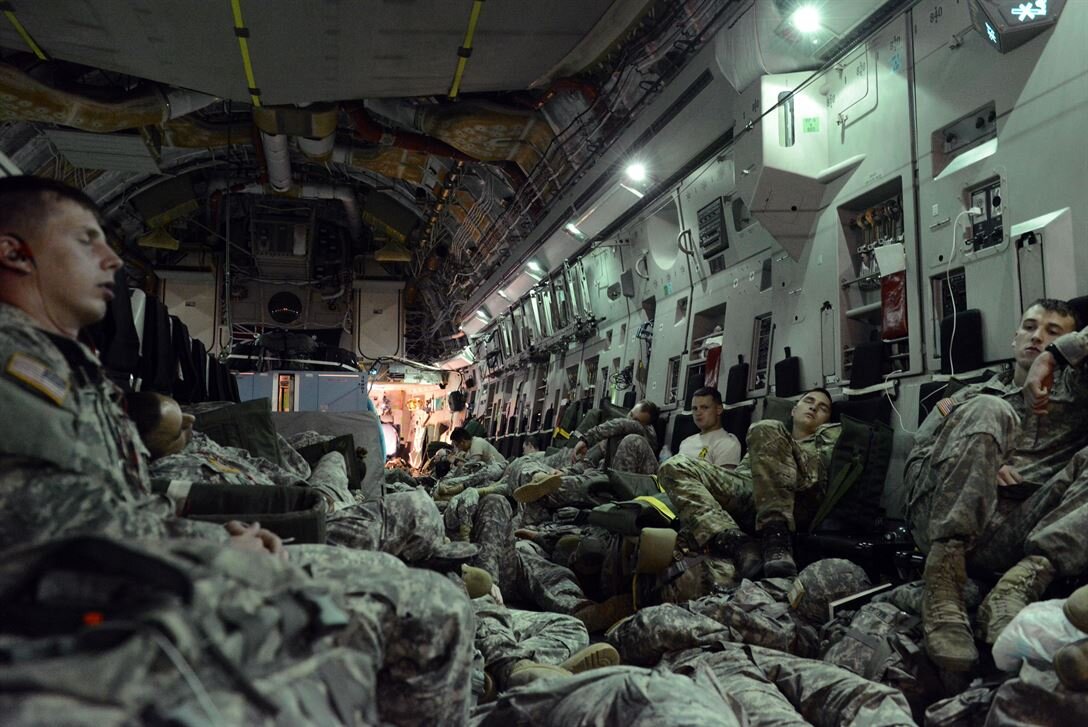With DREEMS, mission planners, analysts, and researchers can understand and model the impact of stressors on a Warfighter’s performance. Their insights can ultimately improve Warfighter lethality, survivability, and operational effectiveness on the battlefield.

Paratroopers on a 17-hour flight trying to get some pre-jump rest on the aircraft. (Image: Defense.gov)
“The Army is working with us to enhance our DREEMS approach to ensure troops operate at peak performance. DREEMS lets them deeply understand the effects of fatigue, stress, and other moderators on cognitive and physical performance.”
– Dr. Peter Weyhrauch, Division VP of Human-Centered Intelligent Systems
Stressors, such as heavy gear, sleep deprivation, and temperature extremes, are an expected and common part of a Warfighter’s life on the battlefield. Without rest or support, though, these stressors can cripple an effective unit, even on the easiest terrain. The effects of stressors multiply exponentially with rough ground and bad weather—the more hills a Warfighter must climb and the worse the weather, the faster they will tire. Similarly, carrying too much weight with too little sleep also accelerates exhaustion. This performance degradation can result in serious, costly mistakes and slower reaction times, which can mean the difference between life and death for a Warfighter.
Helping analysts model stressors faced by Warfighters
How does fatigue from carrying a heavy load all day degrade decision-making speed and accuracy during a room clear? Does physical exhaustion reduce situational awareness and degrade the quality of threat assessment? Our research approach uses cognitive reasoning and modeling so analysts can better understand exactly how fatigue and other stressors may impact Warfighters’ decision making during specific tasks.
To provide a basic understanding of the causes and effects of stressors and supporting data (that is, to characterize these stressors), we teamed with Professor Frank Ritter, Professor Christopher Dancy, and Dr. Victor Middleton to develop Dynamic Representation for Evaluating the Effect of Moderators and Stress on Performance (DREEMS) for the US Army. The tools developed under DREEMS help analysts characterize fatigue and other stressors, characterize cognitive and physiological task performance, and develop methodologies for understanding, analyzing, and predicting how fatigue and other stressors arise and affect a Warfighter’s performance.


Warfighter agents powered by the data from the CTA Tool using the Hap architecture interact within our 3D simulation environment, SkirmishSim.
DREEMS augments numerous military planning and visualization systems, including military modeling and simulation (M&S). In particular, DREEMS improves an analyst’s ability to characterize fatigue and other stressors, including sources and effects of fatigue on performance. The approach also allows analysts to assess how these stressors arise and how they degrade operational performance over time.
This material is based upon work supported by the US Army Command Center, Aberdeen Proving Ground, Natick Contracting Division ACC-APG-NCD under Contract No. W911QY-17-C-0009. Any opinions, findings and conclusions or recommendations expressed in this material are those of the author(s) and do not necessarily reflect the views of the US Army Command Center, Aberdeen Proving Ground, Natick Contracting Division ACC-APG-NCD. The appearance of U.S. Department of Defense (DoD) visual information does not imply or constitute DoD endorsement.
